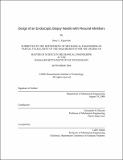Design of an endoscopic biopsy needle with flexural members
Author(s)
Figueredo, Stacy L. (Stacy Lee), 1981-
DownloadFull printable version (5.550Mb)
Other Contributors
Massachusetts Institute of Technology. Dept. of Mechanical Engineering.
Advisor
Alexander H. Slocum.
Terms of use
Metadata
Show full item recordAbstract
As a minimally invasive means of extracting a tissue sample from a patient, current endoscopic biopsy needles generally do not preserve tissue histology and often require multiple attempts to obtain a tissue sample. This paper presents an endoscopic biopsy needle with internal flexures that enable tissue to enter the hollow needle and then be severed from surrounding tissue when the needle is withdrawn. Using force-deflection and sample weight data from 10x scaled prototypes, variations of a flexural design captured 1.1 grams of a tissue phantom on average, as compared to wedge-type designs that averaged of 0.7-0.8 grams. Peak entrance forces for the flexure design were lower than for both wedge and extended wedge designs, and resistance forces were higher upon needle extraction. A low-angle 15-degree feature produced lower entrance resistance and larger exit resistance compared with 30 degree, 45 degree, and 60 degree features, which is desirable when retaining tissue. Manufacturing of a 1x scale prototypes, using a grinding and laser cutting process, suggested that flexural features could be produced in current endoscopic biopsy needles, but changes to the beveled cutting tip would first have to be made before flexural elements could be tested on actual liver samples.
Description
Thesis (S.M.)--Massachusetts Institute of Technology, Dept. of Mechanical Engineering, 2006. Includes bibliographical references (p. 96-97).
Date issued
2006Department
Massachusetts Institute of Technology. Department of Mechanical EngineeringPublisher
Massachusetts Institute of Technology
Keywords
Mechanical Engineering.